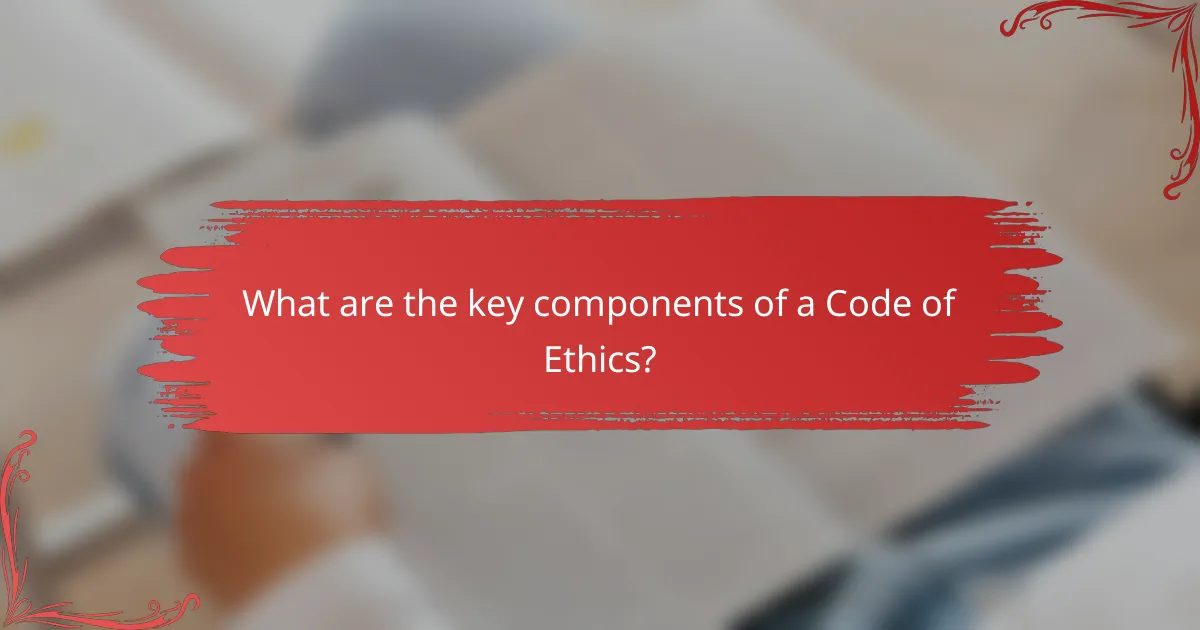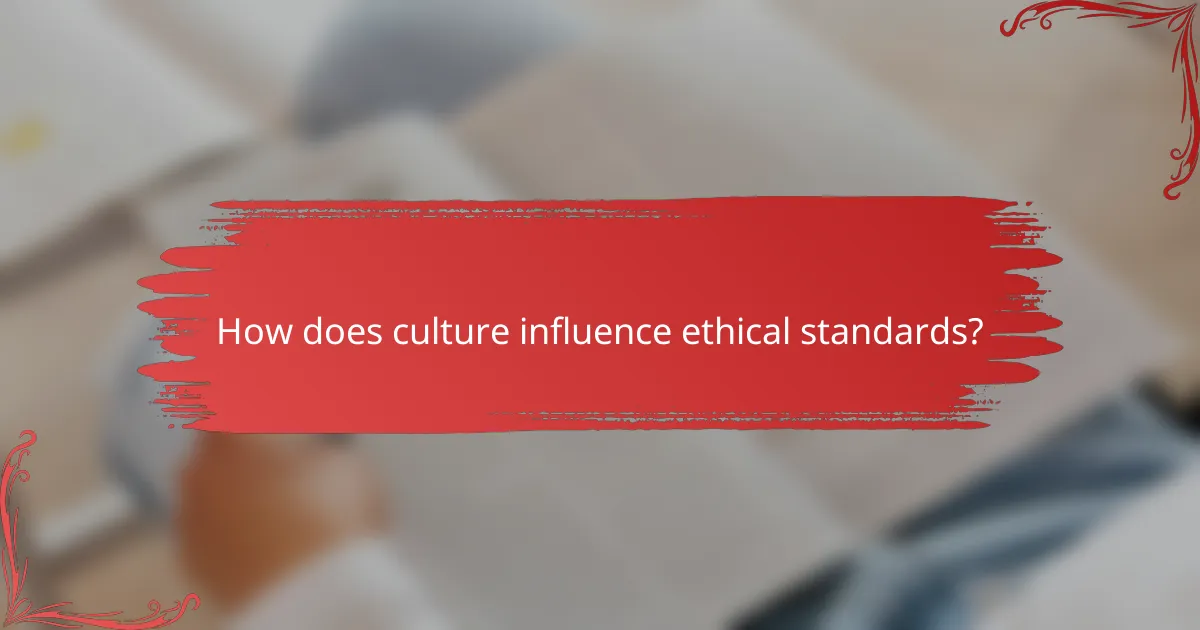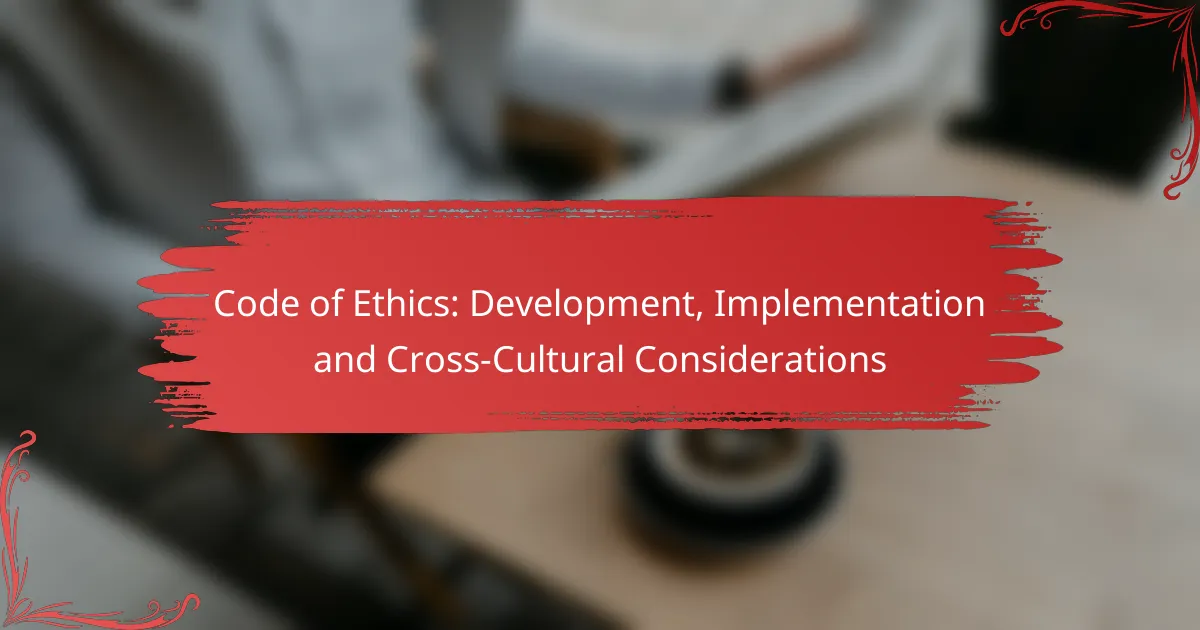A Code of Ethics serves as a foundational framework that outlines the principles guiding an organization’s values and behavior. Its development and implementation are crucial for promoting ethical decision-making and fostering a culture of integrity. By establishing clear guidelines, providing training, and ensuring ongoing communication, organizations can align employee actions with their ethical standards, while also considering cross-cultural differences that may influence ethical perceptions and practices.

What are the key components of a Code of Ethics?
A Code of Ethics typically includes principles that guide behavior, standards of conduct, accountability measures, compliance guidelines, and stakeholder engagement strategies. These components work together to create a framework that promotes ethical decision-making and fosters a culture of integrity within an organization.
Principles of integrity
Principles of integrity form the foundation of a Code of Ethics, emphasizing honesty, transparency, and fairness. Organizations should clearly define these principles to ensure all members understand the importance of ethical behavior in their actions.
For instance, an organization may state that all employees must act with honesty in all business dealings, which can help build trust both internally and externally. Regular training sessions can reinforce these principles and encourage open discussions about ethical dilemmas.
Standards of conduct
Standards of conduct outline the expected behaviors and practices for individuals within the organization. These standards should be specific and actionable, detailing what is considered acceptable and unacceptable behavior.
Examples include guidelines on conflicts of interest, confidentiality, and respectful communication. Organizations can benefit from regularly reviewing and updating these standards to reflect changes in laws, regulations, and societal expectations.
Accountability measures
Accountability measures ensure that individuals are held responsible for their actions in relation to the Code of Ethics. This can include mechanisms for reporting unethical behavior and processes for investigating complaints.
Implementing a whistleblower policy can encourage employees to report misconduct without fear of retaliation. Regular audits and assessments can also help organizations evaluate compliance with ethical standards and identify areas for improvement.
Compliance guidelines
Compliance guidelines provide a framework for adhering to legal and regulatory requirements relevant to the organization’s operations. These guidelines should be clear and accessible to all employees.
Organizations may need to include specific laws or regulations that apply to their industry, such as data protection laws or anti-corruption statutes. Training programs can help ensure that employees understand these guidelines and their implications for daily operations.
Stakeholder engagement
Stakeholder engagement involves actively involving all parties affected by the organization’s actions in discussions about ethical practices. This includes employees, customers, suppliers, and the community.
Regular feedback mechanisms, such as surveys or focus groups, can help organizations gauge stakeholder perceptions and expectations regarding ethical behavior. Engaging stakeholders can lead to more robust ethical standards and foster a culture of accountability and trust.

How to develop a Code of Ethics?
Developing a Code of Ethics involves outlining the principles that guide an organization’s values and behavior. This process ensures that ethical standards are clearly defined and communicated to all stakeholders.
Identify core values
Identifying core values is the first step in creating a Code of Ethics. These values should reflect the organization’s mission and vision while resonating with its culture. Common core values include integrity, respect, accountability, and transparency.
Consider conducting surveys or workshops to gather input from employees about what values they believe are essential. This engagement helps ensure that the identified values are relevant and embraced by the team.
Engage stakeholders
Engaging stakeholders is crucial for developing a comprehensive Code of Ethics. Stakeholders can include employees, management, customers, and even suppliers. Their insights can provide diverse perspectives on ethical expectations and concerns.
Hold meetings or focus groups to discuss ethical dilemmas and gather feedback on proposed values. This collaborative approach fosters a sense of ownership and commitment to the final document.
Draft the document
Drafting the Code of Ethics involves translating the identified values and stakeholder input into a formal document. The draft should clearly articulate the ethical standards and behaviors expected from all members of the organization.
Use clear and concise language, and consider including examples of acceptable and unacceptable behaviors. This clarity will help prevent misunderstandings and ensure that everyone knows what is expected.
Review and revise
Reviewing and revising the Code of Ethics is essential to ensure its relevance and effectiveness. This process should involve multiple stakeholders to gather diverse opinions and suggestions for improvement.
Set a timeline for regular reviews, such as annually or biennially, to keep the document up to date with changing laws, regulations, and organizational goals. Encourage feedback from employees to continuously refine the Code and address any emerging ethical issues.

What are best practices for implementing a Code of Ethics?
Best practices for implementing a Code of Ethics include establishing clear guidelines, providing comprehensive training, and ensuring ongoing communication. These practices help organizations foster a culture of integrity and accountability, aligning employee behavior with ethical standards.
Training programs
Effective training programs are essential for ensuring that employees understand the Code of Ethics and its implications. These programs should be tailored to the specific needs of the organization and can include workshops, online courses, or interactive sessions. Regular training sessions, ideally conducted annually, help reinforce ethical standards and keep them top of mind.
Consider incorporating real-life scenarios and case studies relevant to your industry during training. This approach allows employees to engage with the material and apply ethical principles to practical situations they may encounter in their roles.
Communication strategies
Clear communication strategies are vital for promoting the Code of Ethics throughout the organization. This can involve regular updates via newsletters, emails, or dedicated intranet pages that highlight ethical practices and provide resources for employees. Encouraging open discussions about ethics can also help create a transparent environment where employees feel comfortable raising concerns.
Utilizing multiple channels, such as meetings, posters, and digital platforms, ensures that the message reaches all employees effectively. Tailoring communication to different departments or teams can enhance relevance and engagement.
Monitoring compliance
Monitoring compliance with the Code of Ethics is crucial for maintaining its effectiveness. Organizations should establish mechanisms for reporting unethical behavior, such as anonymous hotlines or designated ethics officers. Regular audits and assessments can help identify areas for improvement and ensure adherence to ethical standards.
Consider implementing key performance indicators (KPIs) related to ethical behavior, such as the number of reported incidents or employee feedback on ethical culture. This data can guide adjustments to training programs and communication strategies, fostering a continuous improvement cycle in ethical practices.

How does culture influence ethical standards?
Culture significantly shapes ethical standards by defining what is considered right or wrong within a society. Different cultural backgrounds lead to varying interpretations of ethical behavior, impacting decision-making processes in both personal and professional contexts.
Variations in ethical perceptions
Ethical perceptions can differ widely across cultures, often influenced by historical, religious, and social factors. For instance, collectivist societies may prioritize group harmony over individual rights, while individualistic cultures often emphasize personal freedom and autonomy. These variations can lead to misunderstandings in international business dealings.
To navigate these differences, organizations should conduct cultural assessments to understand the ethical frameworks of their stakeholders. This can help in developing policies that respect diverse ethical viewpoints while maintaining core organizational values.
Impact of cultural norms
Cultural norms dictate acceptable behavior and influence ethical standards within a community. For example, in some cultures, transparency and honesty are paramount, while in others, maintaining face and avoiding conflict may take precedence. These norms can affect how ethical dilemmas are approached and resolved.
Organizations should be aware of these cultural norms when implementing ethical guidelines. Training programs that include cultural sensitivity can help employees recognize and respect these differences, fostering a more inclusive workplace.
Case studies in cross-cultural ethics
Case studies illustrate the complexities of cross-cultural ethics. One example is the differing approaches to bribery; in some cultures, it may be seen as a standard business practice, while in others, it is strictly prohibited. Understanding these nuances is crucial for multinational companies to avoid legal and reputational risks.
Another case involves the varying attitudes towards labor practices. In regions with strong labor rights, companies may face backlash for not adhering to strict ethical labor standards, while in other areas, such practices may be overlooked. Analyzing such case studies can provide valuable insights for developing effective cross-cultural ethical strategies.

What are the challenges in enforcing a Code of Ethics?
Enforcing a Code of Ethics can be difficult due to various challenges, including resistance to change, resource limitations, and legal implications. Organizations must navigate these hurdles to ensure ethical standards are upheld effectively.
Resistance to change
Resistance to change is a common challenge when implementing a Code of Ethics. Employees may be accustomed to existing practices and skeptical about new ethical guidelines, leading to pushback. To overcome this, organizations should involve staff in the development process and communicate the benefits of the Code clearly.
Training sessions and workshops can help ease the transition by fostering a culture of openness and understanding. Highlighting real-world examples of ethical dilemmas can also illustrate the importance of adhering to the Code.
Resource limitations
Resource limitations can significantly hinder the enforcement of a Code of Ethics. Organizations may lack the necessary budget, personnel, or time to implement comprehensive training and monitoring programs. Prioritizing ethical initiatives and allocating resources effectively is crucial for success.
Consider starting with a phased approach, focusing on the most critical areas first. Utilizing existing staff for training and leveraging online resources can also help mitigate costs while still promoting ethical practices.
Legal implications
Legal implications pose another challenge in enforcing a Code of Ethics. Organizations must ensure that their ethical guidelines comply with local laws and regulations to avoid legal repercussions. This requires a thorough understanding of relevant legislation and potential liabilities.
Regularly reviewing and updating the Code in light of changing laws is essential. Consulting with legal experts can provide valuable insights and help organizations navigate complex legal landscapes effectively.
